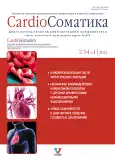Clinical, electrophysiological, molecular, and genetic characteristics of patients with Wolf–Parkinson–White syndrome: literature review
- Authors: Tolstokorova Y.A.1, Nikulina S.Y.1, Chernova A.A.1,2
-
Affiliations:
- Voino-Yasenetsky Krasnoyarsk State Medical University
- Federal Siberian Scientific and Clinical Center
- Issue: Vol 14, No 1 (2023)
- Pages: 59-66
- Section: Reviews
- URL: https://journals.rcsi.science/2221-7185/article/view/134162
- DOI: https://doi.org/10.17816/CS134114
- ID: 134162
Cite item
Full Text
Abstract
The Wolf–Parkinson–White (WPW) syndrome is a condition with early excitation of the heart ventricles due to the conduction of an electrical pulse along the atrioventricular pathway, such as the Kent, James bundle, and Mahaim fibers; the pulse is usually accompanied by supraventricular tachycardia, atrioventricular reciprocal tachycardia in 95% of cases, and fibrillation, atrial flutter, and other supraventricular tachycardia in other cases. WPW syndrome can be observed in patients of any age, approximately 1–30 per 10,000 people, with male predominance. The disease affects 0.15–0.25% of the population. Sudden cardiac death occurs in one patient per 1000 annually, and sometimes this is the first "business card" of the disease. This is mainly due to the lightning-fast formation of life-threatening arrhythmias, for example, with the transformation of atrial fibrillation into ventricular fibrillation. The morphological substrate is an additional atrioventricular connection. Currently, transcatheter radiofrequency ablation is the standard of the interventional treatment of WPW syndrome. WPW syndrome has a diverse etiology. Numerous studies reported that genetics play a significant role in the development of WPW syndrome. Several genetic predictors of WPW syndrome are presented in the modern literature, which may be relevant in predicting and diagnosing hidden forms of this syndrome, such as course, development of symptoms and manifestations, and reduction of the risks of sudden cardiac death.
Full Text
##article.viewOnOriginalSite##About the authors
Yuliya A. Tolstokorova
Voino-Yasenetsky Krasnoyarsk State Medical University
Email: nicoulina@mail.ru
ORCID iD: 0000-0002-2261-0868
SPIN-code: 7969-2108
graduate student
Russian Federation, KrasnoyarskSvetlana Y. Nikulina
Voino-Yasenetsky Krasnoyarsk State Medical University
Author for correspondence.
Email: nicoulina@mail.ru
ORCID iD: 0000-0002-6968-7627
SPIN-code: 1789-3359
MD, Dr. Sci. (Med.), Professor, department head
Russian Federation, KrasnoyarskAnna A. Chernova
Voino-Yasenetsky Krasnoyarsk State Medical University; Federal Siberian Scientific and Clinical Center
Email: nicoulina@mail.ru
ORCID iD: 0000-0003-2977-1792
SPIN-code: 6094-7406
MD, Dr. Sci. (Med.), department professor
Russian Federation, Krasnoyarsk; KrasnoyarskReferences
- Shlyakhto EV, editor. Kardiologiya: natsional’noe rukovodstvo. Moscow: GEOTAR-Media; 2021. (In Russ).
- Chernova AA, Matyushin GV, Nikulina SYu, et al. Wolff–Parkinson–White syndrome (literature review). RMJ. 2017;4:269–272. (In Russ).
- Ardashev AV, Rybachenko MS, Zheljakov EG, et al. Wolff–Parkinson–White Syndrome: Classification, Clinical Manifestations, Diagnosis, and Treatment. Kardiologija. 2009;10:84–94. (In Russ).
- Mamchur SE, Ardashev AV. Sudden cardiac death and Wolf–Parkinson–White syndrome. Journal of Arrhythmology. 2014;76:30–36. (In Russ).
- Ardashev VN, Ardashev AV, Steklov VI. Lechenie narushenii serdechnogo ritma. Moscow: Medpraktika-M; 2005. (In Russ).
- Kruchina TK, Egorov DF, Tatarsky B.A. Wolf–Parkinson–White phenomen and syndrome in children: clinical and physiological difference. Journal of Arrhythmology. 2011;66:13–18. (In Russ).
- Bockeria OL, Akhobekov AA. Wolf–Parkinson–White syndrome. Annaly aritmologii. 2015;12(1):25–37. (In Russ). doi: 10.15275/annaritmol.2015.1.4
- Zhang Y, Wang L. Atrial vulnerability is a major mechanism of paroxysmal atrial fibrillation in patients with Wolff–Parkinson–White syndrome. Med Hypotheses. 2006;67(6):1345–1347. doi: 10.1016/j.mehy.2006.02.053
- Belenkov Yu, Rybatchenko MS, Zhelyakov EG, et al. Echocardiographic Parameters in Patients With Wolf–Parkinson–White Syndrome Before and During One Year After Radiofrequency Catheter Ablation of Accessory Atrioventricular Junction. Kardiologiia. 2011;6:66–82. (In Russ).
- Bockeria LA, Melikulov AH. Wolf–Parkinson–White syndrome. Annaly aritmologii (Annals of arrhythmology). 2008;2:5–19. (In Russ).
- Kushakovsky MS, Grishkin YuN. Aritmii serdtsa. St. Petersburg: Foliant; 2020. (In Russ).
- Revishvili AS, Boytsov SA, Davtyan KV, et al. Klinicheskie rekomendatsii VNOA po provedeniyu elektrofiziologicheskikh issledovanii, kateternoi ablyatsii i primeneniyu implantiruemykh antiaritmicheskikh ustroistv. Moscow: Novaya redaktsiya; 2013. (In Russ).
- Bokeria LA, Bokeria OL, Melikulov AH, et al. Electrocardiographic and electrophysiological topical diagnosis of Wolf–Parkinson–White syndrome and results of radiofrequency ablation of additional atrioventricular junctions in patients with Ebstein anomaly. Annaly aritmologii (Annals of arrhythmology). 2013;10(4):180–186. (In Russ). doi: 10.15275/annaritmol.2013.4.1
- Klimenko AA, Tverdova NA. Diagnosis and treatment of atrial fibrillation (in accordance with the ACC/AHA/ESC 2006 guidelines). Part 1. The Сlinician. 2006;1(4):52–58. (In Russ).
- Fomina IG, Kuleshovn NP, Logunova LV, et al. Medico-genetic counseling in primary arrhythmia prevention. Cardiovascular therapy and prevention. 2007;7(7):74–77. (In Russ).
- Gollob MH, Green MS, Tang A, et al. Identification of a gene responsible for familial Wolff–Parkinson–White syndrome. N Engl J Med. 2001;344(24):1823–1864. doi: 10.1056/NEJM200106143442403
- Milewicz DM, Seidman CE. Genetics of Cardiovascular Disease. Circulation. 2000;102(20 Suppl 4):IV103–IV111. doi: 10.1161/01.cir.102.suppl_4.iv-103
- Bokeria LA, Revishvili AS, Rzaev FG, et al. Electrophysiological diagnostics and interventional treatment of patients with inferior paraseptal additional atrioventricular connections. The Bulletin of Bakoulev Center. Cardiovascular Diseases. 2007;8(6):13–19. (In Russ).
- Matyushin GV, Nikulina SYu, Chernova AA, et al. Polymorphisms of endothelial nitric oxide synthase gene as predictors of Wolf–Parkinson–White Syndrome. Rational Pharmacotherapy in Cardiology. 2017;13(5):597–601. (In Russ). doi: 10.20996/1819-6446-2017-13-5-597-601
- Vaughan CJ, Hom Y, Okin DA, et al. Molecular genetic analysis of PRKAG2 in sporadic Wolff–Parkinson–White syndrome. J Cardiovasc Electrophysiol. 2003;14(3):263–268. doi: 10.1046/j.1540-8167.2003.02394.x
- Weng KP, Yuh YS, Huang SH, et al. PRKAG3 polymorphisms associated with sporadic Wolffe–Parkinsone–White syndrome among a Taiwanese population. J Chin Med Assoc. 2016;79(12):656–660. doi: 10.1016/j.jcma.2016.08.008
- Murphy RT, Mogensen J, McGarry K, et al. Adenosine monophosphate-activated protein kinase disease mimicks hypertrophic cardiomyopathy and Wolff–Parkinson–White syndrome: natural history. J Am Coll Cardiol. 2005;45(6):922–930. doi: 10.1016/j.jacc.2004.11.053
- Bittinger LD, Tang AS, Leather RA. Three Sisters, One Pathway. Can J Cardiol. 2011;27(6):870.e5–870.e6. doi: 10.1016/j.cjca.2011.04.009
- Vohra J, Skinner J, Semsarian C. Cardiac genetic investigation of young sudden unexplained death and resuscitated out of hospital cardiac arrest. Heart Lung Circ. 2011;20(12):746–750. doi: 10.1016/j.hlc.2011.07.015
- Chernova AA, Matyushin GV, Nikulina SYu, et al. Polymorphisms of sodium voltage-gated channel gene (scn5a) as a predictors of Wolff–Parkinson–White syndrome. Transbaikalian medical bulletin. 2017;3:67–71. (In Russ).
- Han B, Wang Y, Zhao J, et al. Association of T-box gene polymorphisms with the risk of Wolff–Parkinson–White syndrome in a Han Chinese population. Medicine (Baltimore). 2022;101(32):e30046. doi: 10.1097/MD.0000000000030046
Supplementary files







